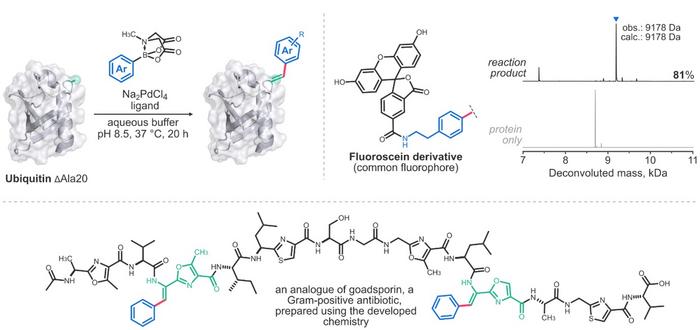
Pharmaceutical science is on the cusp of a significant breakthrough, thanks to the innovative work of researchers at the National University of Singapore (NUS) and the University of Tokyo. They have developed a novel chemical reaction that enhances the functionalization of peptides and proteins, two fundamental components that play critical roles in biological systems and therapeutic applications. This advancement in bioconjugation chemistry could ultimately streamline drug discovery processes and offer improved methodologies for the modification of complex biomolecules.
Peptides and proteins, being intricately structured biomolecules, exhibit vast functionalities. However, the selective modification of these large molecules remains a formidable challenge. The primary hurdle lies in their structure—proteins contain multiple functional groups that share similar reactivity profiles, complicating efforts to achieve targeted modifications without unintended side reactions. Currently, many existing chemical methods yield complex mixtures, which not only create difficulties in control and reproducibility but also may introduce components with off-target effects.
To surmount these challenges, Assistant Professor Alexander Vinogradov and his team, in collaboration with Professor Hiroaki Suga, have pioneered a palladium-mediated coupling reaction that operates efficiently under mild, ambient conditions, specifically in aqueous environments. This reaction leverages cost-effective reagents, notably boronic acid derivatives, to achieve selective bioconjugation. A breakthrough in this method is its specificity for peptides and proteins containing dehydroalanine, a non-canonical, yet frequently occurring amino acid in numerous proteins and secondary metabolites. This specificity represents a significant of advancing the field of protein chemistry.
Moreover, the novel reaction enables the incorporation of dehydrophenylalanine into peptide structures. This unusual amino acid is of considerable interest, as it promotes the folding of peptides into stable, unique conformations. Such structural integrity can markedly enhance the metabolic stability and bioavailability of peptide-based drugs, making this development particularly promising for pharmaceutical applications.
The research team’s findings were documented in a study published in the Journal of the American Chemical Society. Their publication, dated February 21, 2025, provides comprehensive insights into the efficiency and reliability of this new coupling method. Notably, they successfully applied the reaction to peptides synthesized via cell-free translation—an innovative approach that supports rapid and efficient access to previously elusive structures enriched with dehydrophenylalanine.
As emphasized by Prof. Vinogradov, the power of mRNA display in identifying bioactive peptides has been well recognized in the scientific community. With their newly minted coupling chemistry, the researchers aim to elevate this technique further to identify compounds that exhibit high drug-likeness. The integration of structurally diverse peptides into the mRNA display process could prove transformative, accelerating the discovery of effective peptide inhibitors pertinent to various therapeutically relevant protein targets.
Looking towards future applications, the team intends to marry their innovative chemical techniques with existing drug discovery methodologies. The goal is to streamline the process of identifying peptide inhibitors that possess the potential to modulate critical biological pathways. Such integrations could accelerate the translation of laboratory discoveries into viable therapeutic options for a variety of conditions, paralleling the pace of modern medicinal chemistry’s demands.
Incorporating selective chemistry of this caliber into peptide synthesis not only opens new pathways for therapeutic development but also fosters collaborations across disciplines in the realms of physical and life sciences. Researchers worldwide are poised to adopt these methods, advocating for a paradigm shift in how peptide and protein research is conducted, particularly in drug discovery endeavors.
As their work continues to garner attention, the implications of the developed coupling reaction will undoubtedly resonate throughout the biomedical and pharmaceutical fields. The potential for generating customized biomolecular tools with high specificity and efficacy could yield numerous applications, from targeted therapies to innovative diagnostic tools.
In conclusion, advancements in peptide and protein modification methodologies are more important than ever. The work initiated by Vinogradov and Suga highlights the crucial intersection of chemistry and biology, emphasizing how innovative chemical strategies can propel the drug discovery landscape forward. The scientific community eagerly anticipates further developments from this promising avenue, paving the way for novel therapeutic agents and improved treatment methodologies for an array of diseases.
The implications of this research extend far beyond the immediate findings; they herald a new era in bioconjugate chemistry where precision meets affordability, setting a precedent for future explorations in the field. These advancements bridge gaps in our current understanding and capabilities, all while fostering a collaborative spirit among scientists dedicated to solving complex biological challenges.
This significant breakthrough holds transformative potential not just for research laboratories, but for the pharmaceutical industry at large. As these innovative techniques emerge into the public domain, they could quite possibly modify the trajectory of therapeutic drug development and molecular biology research for years to come.
Subject of Research: Bioconjugation and protein modification techniques in drug discovery
Article Title: Ligand-Enabled Selective Coupling of MIDA Boronates to Dehydroalanine-Containing Peptides and Proteins
News Publication Date: 21-Feb-2025
Web References: Journal of the American Chemical Society
References: N/A
Image Credits: National University of Singapore
Keywords
Peptides, Chemical reactions, Drug discovery, Medicinal chemistry, Molecular targets, Amino acids, Protein structure, Targeted drug delivery.
Tags: advancements in peptide engineeringambient conditions for chemical reactionsbioconjugation chemistry breakthroughschallenges in protein modification techniquescollaborative efforts in protein engineeringcost-effective reagents in biochemistrydrug discovery process enhancementsinnovative research in pharmaceutical sciencenovel chemical reactions in protein modificationpalladium-mediated coupling reactionsselective functionalization of biomoleculestherapeutic applications of peptides





